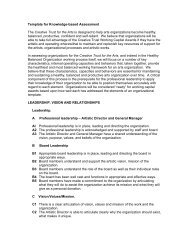20 Questions - Canadian Institute of Chartered Accountants
20 Questions - Canadian Institute of Chartered Accountants
20 Questions - Canadian Institute of Chartered Accountants
Create successful ePaper yourself
Turn your PDF publications into a flip-book with our unique Google optimized e-Paper software.
Introduction<br />
The sustainability <strong>of</strong> a not-for-pr<strong>of</strong>it organization – its ability to continue and<br />
fund its activities year after year – is a major responsibility <strong>of</strong> the board. Directors<br />
need to understand why the organization exists, the interests <strong>of</strong> its stakeholders<br />
and how it manages the risks it faces. They should also be actively involved in the<br />
development and approval <strong>of</strong> its strategy.<br />
An organization’s “strategy” involves:<br />
(1) the determination <strong>of</strong> long term goals (i.e., mission, vision and values) and<br />
objectives which reflect<br />
(a) the relationship that the organization wishes to have with its<br />
different stakeholder groups and,<br />
(b) in particular, how the organization intends to address important<br />
stakeholder needs; and<br />
(2) the identification <strong>of</strong> the scope <strong>of</strong> the activities or programs through<br />
which those goals and objectives are to be achieved. 1<br />
While other definitions <strong>of</strong> strategy exist, this approach is one that answers the<br />
essential questions <strong>of</strong> strategy with which every not-for-pr<strong>of</strong>it board member<br />
should be concerned.<br />
The strategy should be approved by the board <strong>of</strong> directors and reviewed at<br />
least annually. Even where the strategy does not radically change, the process <strong>of</strong><br />
revisiting it can help to reenergize, refocus and renew the organization.<br />
Operational Planning and Budgeting are the processes for deciding what the<br />
organization’s staff and volunteers will do to support the strategy in the next<br />
year or years, what this will cost and where the money will come from. The<br />
board should also approve the plans and budgets which are generally prepared<br />
by the organization’s staff. Board members who are more familiar with business<br />
planning may find the comparison between corporate and not-for-pr<strong>of</strong>it governance<br />
in Appendix 1 to be helpful.<br />
This document has three sections:<br />
Strategic Planning<br />
Operational and Capital Planning and Budgeting<br />
Monitoring and Learning<br />
1 Adapted from: “Lasting inspiration” by Christopher K. Bart, in CAMagazine, May, <strong>20</strong>00, pp. 49-50<br />
4












